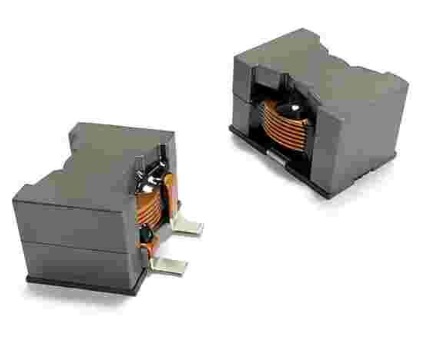Advancements in High Current Inductor Technology for Power Supplies

Advancements in high current inductor technology for power supplies have been driven by the relentless push for efficiency, compactness, and performance in modern applications like EVs, 5G infrastructure, renewable energy, and high-power computing. These inductors—handling 10 A to 500 A or more—have evolved through innovations in materials, construction, and design techniques, tackling heat, saturation, and losses head-on. Let’s explore the latest strides, their impact, and what’s actually cutting through the noise.
Key Advancements
Advanced Core Materials
50 A inductors shrink 20-30% while handling 100 kHz-1 MHz with less heat.
Example: A 100 µH, 80 A inductor in a solar inverter uses MPP for 98% efficiency vs. 95% with ferrite.
High-Flux Metal Alloys: Composites like Sendust (Fe-Si-Al), MPP (Molypermalloy), and amorphous/nanocrystalline alloys offer saturation up to 1.5-2 T (vs. 0.4 T for ferrite) with lower core losses.
Hybrid Cores: Combine ferrite’s high permeability with alloy’s saturation tolerance (e.g., Kool Mµ Max).
Soft Magnetic Composites (SMC): Powdered iron with insulating coatings, enabling 3D flux paths and high-frequency operation.
What’s New:
Impact:
Reality Check: Alloys cost 2-5x more—worth it only for high-density or high-freq apps.
Low-Loss Winding Techniques
A 50 A inductor drops from 10 W to 3 W loss, critical for EV chargers at 400 V.
Example: Edge-wound 150 A inductor in a 100 kW PSU hits 99% efficiency.
Flat Wire/Edge-Wound: Replaces round wire with flat copper strips, slashing DCR (e.g., 2 mΩ vs. 10 mΩ).
Litz Wire Variants: Multi-strand, insulated wires for high-frequency AC (e.g., 500 kHz), cutting skin effect losses.
Foil Windings: Thin copper foils in layers, boosting current density and heat dissipation.
What’s New:
Impact:
Trade-Off: Complex winding ups manufacturing cost and size slightly.
Thermal Management Innovations
20 A at 1 MHz runs 20°C cooler, extending life in dense server PSUs.
Example: A 40 A, 47 µH inductor in a 5G base station stays under 120°C without forced air.
Integrated Heatsinks: Inductors with metal slugs or potting compounds to wick heat (up to 150°C operation).
Thermally Conductive Cores: Alloys with higher thermal conductivity (e.g., 10 W/m·K vs. 4 W/m·K for ferrite).
Open-Frame Designs: Air gaps or skeletal structures for convection cooling.
What’s New:
Impact:
Limit: Adds bulk—compactness takes a hit.
Reduced Parasitics
SRF jumps from 2 MHz to 5 MHz, suiting 1-2 MHz SMPS with stable LLL.
Example: A 100 µH, 30 A inductor in a PFC circuit keeps EMI 10 dB below spec.
Optimized Winding Layouts: Single-layer or spaced turns cut capacitance, pushing SRF (self-resonant freq) higher.
Shielded Designs: Magnetic shielding (e.g., ferrite cups) reduces EMI and leakage inductance.
Distributed Gaps: Micro-gaps in cores spread flux, lowering stray fields.
What’s New:
Impact:
Trade-Off: Shielding adds cost and weight.
Compact, High-Density Designs
A 20 A, 22 µH planar inductor fits a laptop PSU where a toroid wouldn’t.
Example: Coupled 100 A inductor in a 48 V server PSU cuts board space by 40%.
Planar Inductors: PCB-integrated coils with flat cores, stacking layers for LLL.
Coupled Inductors: Multi-phase designs share a core, shrinking footprint in multi-rail PSUs.
SMD Scaling: Surface-mount inductors now hit 50 A in 10x10 mm packages.
What’s New:
Impact:
Limit: Planar types lose efficiency above 100 kHz due to PCB losses.
Wide-Bandgap Integration
Efficiency jumps to 99% in a 400 V, 50 A EV charger at 2 MHz.
Example: A 10 µH, 60 A inductor pairs with GaN in a 1 kW PSU, shrinking 50%.
What’s New: Inductors tailored for SiC/GaN switching at 1-5 MHz (vs. 100 kHz for Si).
How: Low-loss alloys, high-SRF designs, and minimal parasitics.
Impact:
Catch: Needs pricier cores and precision winding.
Applications Driving Advancements
Electric Vehicles (EVs)
Need: 100-500 A at 50-400 V for chargers and traction inverters.
Advance: Flat-wire, high-flux alloys shrink 200 A inductors by 30%, handle 1 MHz GaN switching.
Example: 50 µH, 150 A in a 100 kW onboard charger.
Renewable Energy
Need: 50-200 A in solar/wind inverters at 20-100 kHz.
Advance: Coupled inductors and thermally enhanced cores boost density and uptime.
Example: 300 µH, 80 A in a 10 kW solar inverter.
Data Centers
Need: 20-100 A at 48 V for server PSUs, ultra-compact.
Advance: Planar and SMD inductors fit tight spaces, hit 99% efficiency with SiC.
Example: 22 µH, 40 A in a 1U rack PSU.
5G Infrastructure
Need: 10-50 A at 1-2 MHz for base station power.
Advance: Low-parasitic, high-SRF designs pair with GaN, cut EMI.
Example: 47 µH, 30 A in a 5G RRU (remote radio unit).
Real-World Impact
Efficiency: 1-2% gains (95% → 97%) save kW in grid-scale systems.
Size: 20-50% smaller inductors enable denser PSUs—key for EVs and 5G.
Freq: 1-5 MHz operation with SiC/GaN slashes capacitor size too.
Cost: Premium tech (MPP, flat wire) doubles price—still niche outside high-end.
The hype loves “revolutionary” nano-cores or 99.9% efficiency, but reality favors incremental wins—alloy cores and flat wire do 90% of the heavy lifting. Older powdered iron still holds up for budget 20-50 A jobs—don’t ditch it yet.
Email us
Warning: Undefined variable $pronamepx in D:\wwwroot\www.resistorsupplies.com\moban\en_inc\ziliao.php on line 67
Fatal error: Uncaught TypeError: count(): Argument #1 ($value) must be of type Countable|array, null given in D:\wwwroot\www.resistorsupplies.com\moban\en_inc\ziliao.php:67 Stack trace: #0 D:\wwwroot\www.resistorsupplies.com\ziliao.php(146): include() #1 {main} thrown in D:\wwwroot\www.resistorsupplies.com\moban\en_inc\ziliao.php on line 67
